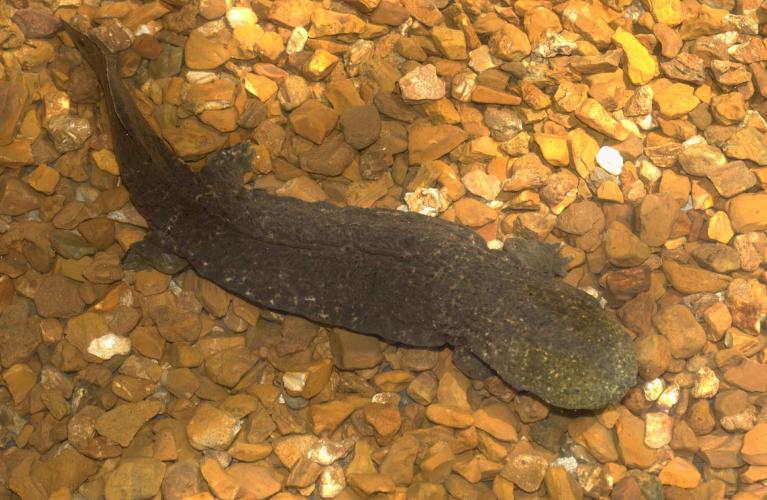
Xplor reconnects kids to nature and helps them find adventure in their own backyard. Free to residents of Missouri.


































Stay in Touch with MDC news, newsletters, events, and manage your subscription

Xplor reconnects kids to nature and helps them find adventure in their own backyard. Free to residents of Missouri.

A monthly publication about conservation in Missouri. Started in 1938, the printed magazine is free to residents of Missouri.


News Release from U. S. Fish and Wildlife Service
The U.S. Fish and Wildlife Service today designated the Ozark hellbender as endangered under the federal Endangered Species Act (ESA) and also finalized its decision to list the Ozark and eastern hellbender in Appendix III of the Convention on International Trade in Endangered Species of Wild Fauna and Flora (CITES). In combination, these listings will provide significant protection to hellbenders, both domestically and internationally.
Under the ESA, an endangered species is any species which is in danger of extinction throughout all or a significant portion of its range. The Ozark hellbender, which grows to lengths up to 2 feet, inhabits the White River system in southern Missouri and northern Arkansas. Ozark hellbender populations have declined an estimated 75 percent since the 1980s, with only about 590 individuals remaining in the wild. It is believed numbers have dropped because of degraded water quality, habitat loss resulting from impoundments, ore and gravel mining, sedimentation , and collection for the pet trade.
Also threatening the Ozark hellbender is a fungal disease, chytridiomycosis (chytrid), and severe physical abnormalities (e.g., lesions, digit and appendage loss, epidermal sloughing) which most Ozark hellbenders exhibit.
In addition, the average age of Ozark hellbender populations is increasing and few young are being found, indicating problems with reproduction or juvenile survival. This, and the multiple threats from disease and habitat degradation, could lead to extinction of the Ozark hellbender within 20 years.
“The Ozark hellbender faces extinction without the protection afforded by the Endangered Species Act,” said Tom Melius, the Service’s Midwest Regional Director. “Listing provides tools and an infrastructure within which partners can pool resources and expertise to help save this species.”
The Service determined that designating critical habitat under the ESA for the Ozark hellbender is not prudent because the designation would require publication of detailed descriptions of hellbender locations and habitat, making illegal collection for the pet trade more likely.
To better control and monitor the international trade of hellbenders, the Service has included both the Ozark and eastern hellbender in Appendix III of the Convention on International Trade in Endangered Species of Wild Fauna and Flora (CITES or Convention). CITES is an international agreement between governments designed to prevent species from becoming endangered or extinct as a result of international trade. Collection within the United States and international trade of hellbenders is of growing concern, particularly as they become rarer and, consequently, more valuable. Listing hellbenders in Appendix III of CITES would aid in curbing unauthorized international trade, not only by controlling exports from the United States but by enlisting the assistance of 174 other countries that are CITES Parties in controlling trade in the species.
Currently, two subspecies of hellbenders are recognized, the Ozark hellbender and the eastern hellbender. The Ozark hellbender only occurs in Missouri and Arkansas, whereas the eastern hellbender range includes portions of the following 16 States: Alabama, Georgia, Illinois, Indiana, Kentucky, Maryland, Mississippi, Missouri, New York, North Carolina, Ohio, Pennsylvania, South Carolina, Tennessee, Virginia, and West Virginia.
Hellbenders are salamanders with large tails and tiny eyes. Adult Ozark hellbenders may reach lengths up to 2 feet, and their flattened bodies enable them to move in the fast-flowing streams they inhabit. Hellbenders are habitat specialists that depend on constant levels of dissolved oxygen, temperature, and flow in their aquatic environment. Even minor alterations to stream habitat are likely detrimental to hellbender populations.
The Endangered Species Act makes it illegal to kill, harm or otherwise "take" a listed species. The ESA also requires all federal agencies to ensure actions they authorize, fund, or undertake do not jeopardize the existence of listed species, and directs the Service to work with federal agencies and other partners to develop and carry out recovery efforts for those species. Listing also focuses attention on the needs of the species, encouraging conservation efforts by other agencies (federal, state and local), conservation groups, and other organizations and individuals.
The Service’s final rules to list the Ozark hellbender as an endangered species and to include hellbenders in Appendix III of CITES appear in the October 6, 2011, Federal Register. The Ozark hellbender final rule is also available on the Service’s Midwest Region website at www.fws.gov/midwest/endangered, and the final rule to include hellbenders in Appendix III of CITES is also available on the Service’s International Affairs website at www.fws.gov/international. The listing of the Ozark hellbender under the ESA will take effect 30 days after publication of the final rule, whereas the listing of hellbenders in CITES Appendix III will take effect 180 days after publication of the final rule. This additional time is necessary so that the Service can submit required documentation to the CITES Secretariat, which will then notify all CITES Parties of this action taken by the United States.
The mission of the U.S. Fish and Wildlife Service is working with others to conserve, protect, and enhance fish, wildlife, and plants and their habitats for the continuing benefit of the American people. We are both a leader and trusted partner in fish and wildlife conservation, known for our scientific excellence, stewardship of lands and natural resources, dedicated professionals, and commitment to public service. For more information on our work and the people who make it happen, visit www.fws.gov.
USFWS CONTACTS:
Georgia Parham at 812-334-4261 x 1203
Trisha Crabill at 573-234-2132 x 121
Danielle Kessler at 703-358-2644